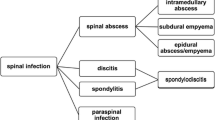Abstract
Purpose
The aim of this study was to review cases of paediatric patients with craniovertebral junction (CVJ) tuberculosis with a view to try and stratify the cases into different groups which would help plan treatment and hence develop a protocol for treatment of a fairly uncommon condition still widely seen in the developing world.
Methods
Twenty-three cases of paediatric craniovertebral tuberculosis had their clinical features and radiology reviewed. The treatment plan in each case was analyzed according to their presentation. The results of treatment after 1 year were assessed in each case.
Results
The clinical presentations varied from neck pain with hypoglossal nerve palsy to frank spastic quadriparesis, and frank instability at the atlanto-axial junction was seen in five out of 23 patients. Cold abscesses were seen in 18/23 cases, and severe torticollis was the presentation in 6/23. We graded the children with this condition into three groups:
-
1)
those with instability and gross neurodeficit who required early operative intervention (1 needed trans-oral decompression with posterior fixation and 4 required posterior fixation)
-
2)
those who had severe torticollis and large cold abscesses who were treated with trans-oral aspiration of cold abscess followed by neck immobilization (6/23) and
-
3)
those who did not have significant neck muscle spasm or torticollis and who were treated with immobilization alone (12/23).
Only one child in group 3 required delayed intervention for instability which developed after completion of the course of anti-tubercular medication.
Conclusions
We concluded that children with craniovertebral tuberculosis should be treated according to their clinical presentation coupled with evidence of radiological instability. Those with gross deficit and instability need early stabilization, those with minimal deficit and no instability but severe pain or torticollis need aspiration of the cold abscess with external immobilization, whereas those without deficit, instability or severe pain may be managed by external orthoses alone. Of course, medical treatment for tuberculosis is necessary in each case.



Similar content being viewed by others
References
Desai SS (1994) Early diagnosis of spinal tuberculosis by MRI. J Bone Joint Surg (Br) 76B:863–869
Edwards RJ, David KM, Crockard HA (2000) Management of tuberculomas of the craniovertebral junction. Br J Neurosurg 14:19–22
Lal AP, Rajshekhar V, Chandy MJ (1992) Management strategies in tuberculous atlanto-axial dislocation. Br J Neurosurg 6:529–535
Behari S, Nayak SR, Bhargava V, Banerji D, Chhabra DK, Jain VK (2003) Craniocervical tuberculosis: protocol of surgical management. Neurosurgery 52:72–81
Teegala R, Kumar P, Kale SS, Sharma BS (2008) Craniovertebral junction tuberculosis: a new comprehensive therapeutic strategy. Neurosurgery 63(5):946–955, discussion 955
Gupta SK, Mohindra S, Sharma BS, Gupta R, Chhabra R, Mukherjee KK, Tewari MK, Pathak A, Khandelwal N, Suresh NM, Khosla VK (2006) Tuberculosis of the craniovertebral junction: is surgery necessary? Neurosurgery 58(6):1144–1150, discussion 1144-50
Sinha S, Singh AK, Gupta V, Singh D, Takayasu M, Yoshida J (2003) Surgical management and outcome of tuberculous atlantoaxial dislocation: a 15-year experience. Neurosurgery 52(2):331–338, discussion 338-9
Al Arabi KM, Al Sebai MW (1992) Evaluation of radiological investigations in spinal tuberculosis. Int Orthop 16:165–167
Arunkumar MJ, Rajashekar V (2002) Outcome in neurologically impaired patients with craniovertebral junction tuberculosis: results of combined anteroposterior surgery. J Neurosurg Spine 97:166–171
Bhojraj SY, Shetty N, Shah PJ (2001) Tuberculosis of the craniocervical junction. J Bone Joint Surg (Br) 83B:222–225
Fang D, Leong JC, Fang HS (1983) Tuberculosis of upper cervical spine. J Bone Joint Surg (Br) 65B:47–50
Krishnan A, Patkar D, Patankar T, Shah J, Prasad S, Bunting T, Castillo M, Mukherji SK (2001) Craniovertebral junction tuberculosis: a review of 29 cases. J Comput Assist Tomogr 25:171–176
Lifeso R (1987) Atlanto-axial tuberculosis in adults. J Bone Joint Surg (Br) 69B:183–187
Moon MS (1997) Tuberculosis of the spine. Controversies and a new challenge. Spine 22:1791–1797
Pandya SK (1971) Tuberculous atlanto-axial dislocation (with remarks on the mechanism of dislocation). Neurol India 19:116–121
Sinha A, Kakkar P (1963) Cervical caries with retropharyngeal abscess. Arch Otolaryngol 78:100–105
Kannan U, Ellis M, Safi T, Kaw MZ, Coates R (1999) Craniocervical junction tuberculosis: a rare but dangerous disease. Surg Neurol 51:21–26
Dhammi IK, Singh S, Jain AK (2001) Hemiplegic/monoplegic presentation of cervical spine (C1-C2) tuberculosis. Eur Spine J 10:540–544
Gorse GJ, Pais MJ, Kuuske JA, Cesario TC (1983) Tuberculous spondylitis: report of 6 cases and review of literature. Medicine 62:178–193
Raut AA, Narlawar RS, Nagar A, Ahmed N, Hira P (2003) An unusual case of CV junction tuberculosis presenting with quadriplegia. Spine 28, E309
Nussaum ES, Rockswold GL, Bergman TA, Erickson DL, Seljeskog EL (1995) Spinal tuberculosis: a diagnostic and management challenge. J Neurosurg 83:243–247
Hoffman EB, Crosier JH, Cremin BJ (1993) Imaging in children with spinal tuberculosis: a comparison of radiography, computed tomography and magnetic resonance imaging. J Bone Joint Surg (Br) 75B:233–239
Sharif HS, Clark DC, Aabed MY, Haddad MC, al Deeb SM, Yaqub B, al Moutaery KR (1990) Granulomatous spinal infections: MR imaging. Radiology 177:101–107
Jain R, Sawhney S, Berry M (1993) Computed tomography of vertebral tuberculosis: patterns of bone destruction. Clin Radiol 47:196–199
Ahmedi J, Bajaj A, Destian S, Segall HD, Zee CS (1995) Spinal tuberculosis: atypical observation at MR imaging. Radiology 189:489–493
Omari B, Robertson JM, Nelson RJ, Chiu LC (1989) Pott’s disease. An urgent challenge to thoracic surgeon. Chest 95:145–150
Author information
Authors and Affiliations
Corresponding author
Rights and permissions
About this article
Cite this article
Chatterjee, S., Das, A. Craniovertebral tuberculosis in children: experience of 23 cases and proposal for a new classification. Childs Nerv Syst 31, 1341–1345 (2015). https://doi.org/10.1007/s00381-015-2695-5
Received:
Accepted:
Published:
Issue Date:
DOI: https://doi.org/10.1007/s00381-015-2695-5




